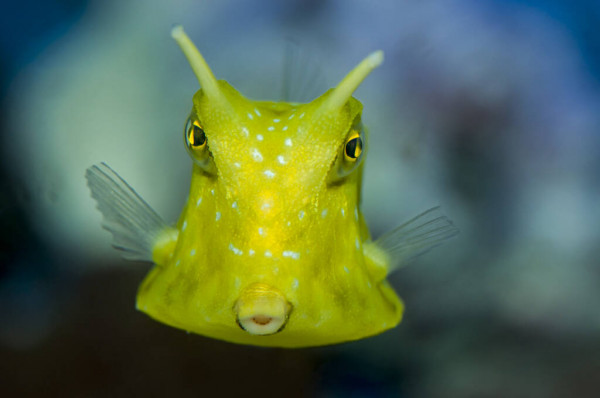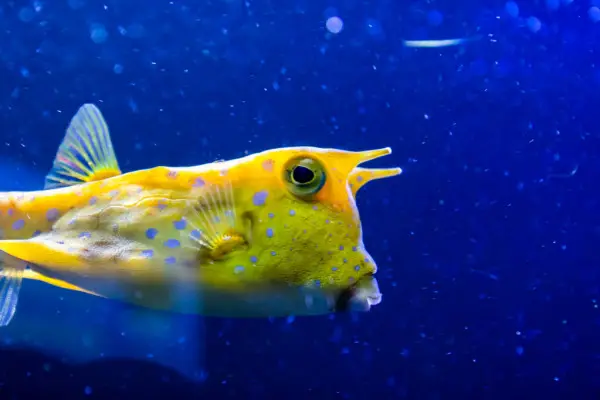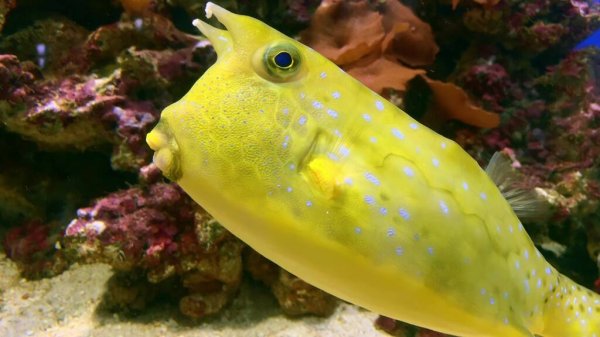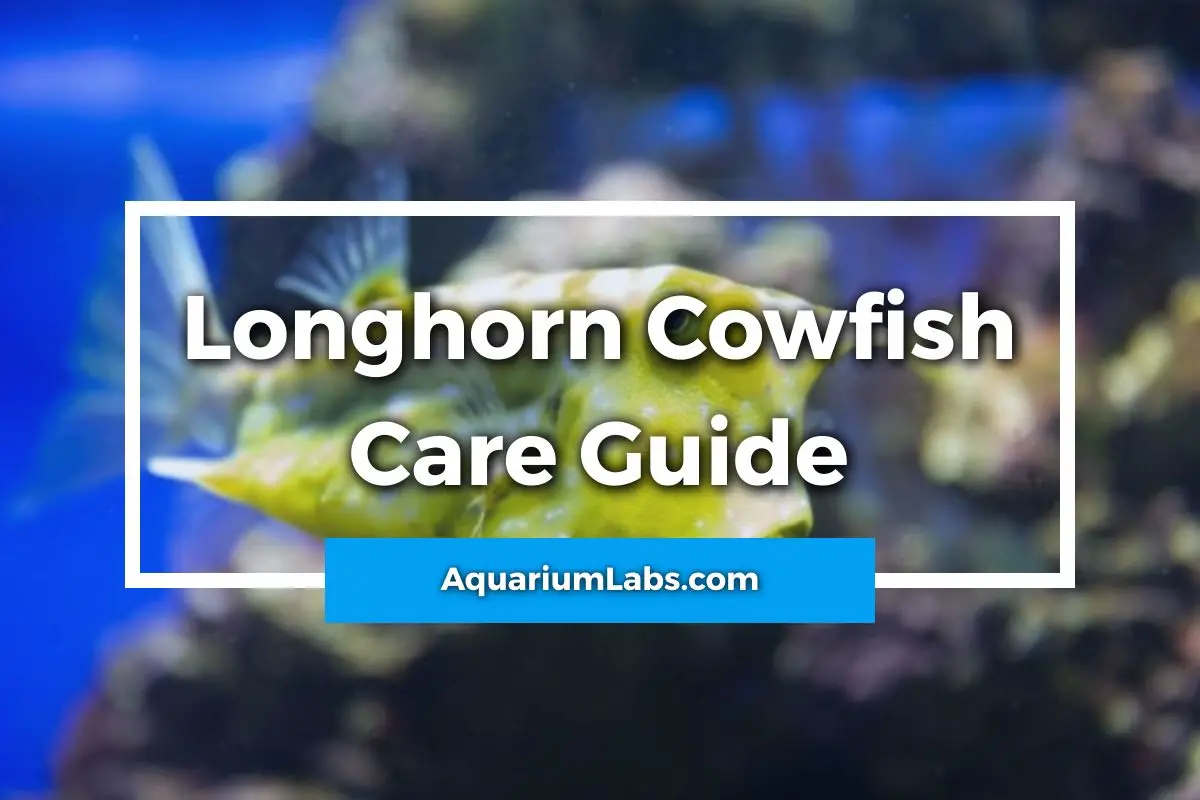The Longhorn Cowfish, Lactoria Cornuta, is one of the largest and most popular of the Cowfish family to enter the hobby.
These Indo Pacific natives are found throughout the region, from the Red Sea and the coast of East Africa to as far west as the Japanese Ryukyu Islands. Their natural habitat also extends far to the south as Lord Howe Island, near Australia.
Cowfish of all kinds are feeders on small crustaceans, polychaete worms, as well as algae and benthic invertebrates. Pretty much anything small and living that can’t outswim them!
Longhorn Cowfish thrive on frozen foods, pellets, and marine algae in the aquarium environment, mixed with occasional algae scraping.
They are extremely cute, aren’t especially sensitive in terms of water quality, and best of all, they are quite peaceful! Still, their sheer size and defensive abilities make them suitable only for expert fish keepers who know what they are getting into.
Getting to Know the Longhorn Cowfish
| Scientific Name | Lactoria Cornuta |
| Origin | Indo Pacific Ocean |
| Length | 16 to 20 inches |
| Temperament | Peaceful |
| Diet | Omnivorous |
| Aquarium Size | 150+ Gallons |
| Reef Safe? | With Caution |
| Ease of Care | Difficult |
Longhorn Cowfish are closely related to Pufferfish, Triggerfish, and even the massive Ocean Sunfish, the largest bony fish in the sea! They are all members of the order Tetraodontiformes, a group of fish that are highly specialized to fit particular environmental niches.
They all have impressive defensive armadas, including the ability to inflate (pufferfish) and sheer size (Ocean Sunfish), but none go quite so far as Cowfish do.
Cowfish have fused, plate-like scales that render the animal tank-like in defense yet also nearly entirely inflexible and prevents it from swimming like other fish.
Longhorn Cowfish instead use a style of movement called ostraciform swimming. This involves undulations of the dorsal (back) and pectoral (side) fins, which most fish use as stabilizers rather than propellers. And unlike most other fish, they lack pelvic fins entirely!
As you can see from the video above, this little Longhorn Cowfish is a very slow swimmer. In fact, they are so slow that they are often caught by hand in the wild by divers!
When caught, they make an angry grunting sound to voice their displeasure and startle you into releasing it. But what if a predator isn’t deterred? Despite their defenses, surely a determined, toothy fish could crack one open, right?
Fortunately, Cowfish have other defenses to make up for being slow swimmers. The prominent horns are actually collagen (cartilage) protrusions that make the fish even harder to get a grip on and swallow. If attacked unsuccessfully, these horns will eventually grow back since they aren’t as hard as bone or scales.

But if they do come across a predatory fish that isn’t deterred by their spines or hard scales, these slow swimmers have a third defensive technique: the ability to release mucus enriched by a hemotoxic (blood poison) chemical called pahutoxin that’s fast-acting and often fatal.
It’s unknown how the Longhorn Cowfish makes this poison, but it’s likely it does so in the same way pufferfish make theirs: partnership with symbiotic bacteria living within their skin cells. Taken as a whole, it’s clear that the Longhorn Cowfish is on the leading edge of the evolutionary arm’s race that marine fish compete in to eat and avoid being eaten!
Cowfish range in size from 5 to 24 inches, and the Longhorn Cowfish, at up to 20 inches in the wild, is one of the larger species. In aquariums, you can expect them to reach up to sixteen inches as an adult.
This makes them suitable for tanks of 150 gallons in size or larger. The below table will give you a brief summary as to what’s involved with Longhorn Cowfish care!
Longhorn Cowfish Appearance
Thanks to their defensive array of weaponry and specialized feeding habits, Longhorn Cowfish are some of the strangest looking fish in the sea. Their fins have soft rays, and their bright yellow coloring advertises their poisonous qualities for all to see.
Many of their cousins also use bright colors to warn predators, including the Yellow Boxfish. Also known as the Polka Dot Boxfish, it is just as common in the aquarium trade as the larger Longhorn Cowfish and just as unpalatable to predators!
Other Cowfish can show different patterns, including white polka dots, black speckles, and blue dots. In each case, the Cowfish is advertising that it’s not only too crunchy to make a good meal but also potentially fatal to a persistent predator.
The Dangers of Pahutoxin
Longhorn Cowfish and other members of their family are very peaceful fish but defensive armadas contained behind a cute appearance. And the most formidable of their defenses is their ability to release toxins from the surface of their skin that will kill all of your favorite fish in mere minutes.
Pahutoxin was formerly known as ostracitoxin since it was discovered in Ostraciidae fish like the Longhorn Cowfish. It’s chemically very similar to tetrodotoxin, produced by their close cousins, the pufferfish, as well as sea cucumber toxins and the poison found in red tide dinoflagellates. Both chemicals are extremely dangerous if ingested or injected through a wound. The famous Japanese pufferfish dish, Fuju, is often called the Russian roulette of the sea because, if improperly prepared, it will leave you dead in hours from a poison with no antidote. Even when properly prepared, traces of the poison leave a numbing sensation in the mouths of diners.
In the wild, this quick puff of pahutoxin that’s released when the cowfish is snatched by a predator would quickly be dispersed by the currents and sheer volume of the ocean. But in an aquarium, the poison simply compounds and circulates, where it causes red blood cells within animals to disintegrate. Other tank members then asphyxiate as they lose the ability to hold dissolved oxygen in their blood. And while the Longhorn Cowfish is resistant to its effects, it’s not entirely immune to the poison. They can be responsible for an entire tank ending up mysteriously dead despite their peaceful disposition.
If the Longhorn Cowfish dies, the decay of its body can also result in pahutoxin being released into the aquarium, poisoning the entire tank in a matter of hours. This is why removing a sick fish to a separate quarantine is essential if you suspect your Longhorn Cowfish is becoming increasingly stressed.
Pahutoxin is not only quick acting but heat-stable and long-lived. Traces of it can soak into your substrate and live rock, potentially poisoning the next batch of fish you add even after breaking down the aquarium!
Related: How to Cure Live Rock
So think long and hard before buying a Longhorn Cowfish and choose their tank mates very carefully. More aggressive fish may induce the cowfish to defend itself in a lethal burst.
Caring for Longhorn Cowfish
Longhorn Cowfish Water Quality
Despite how strange they are, Longhorn Cowfish aren’t especially challenging to provide proper water quality for. They aren’t especially sensitive to ammonia, nitrite, or nitrate, but care should still be taken to remain as close to 0 parts per million as possible for all three parameters. And like the majority of tropical marine fish, they favor temperatures of 72 – 80℉ and specific gravity (salinity) of 1.020-1.025.
Longhorn Cowfish don’t need supplementation of iodine, strontium, or any of the other elements that corals sometimes require. Any standard marine salt blend will contain enough of these elements for your fish to thrive. Since they do eat quite a lot and mostly protein, you’ll want to ensure your filtration is up to the task of processing the ammonia they release. Canister and power filters provide optimal water quality, paired with a protein skimmer to polish dissolved organic matter from your water.
When setting up an aquarium for Longhorn Cowfish, avoid strongly directional filter outflow and powerhead currents that provide no shelter. These fish are such poor swimmers that they can get dashed against the tank glass or coral. And this can result in severe skin wounds, or worse, a cloud of poison from the startled fish.

Sick Longhorn Cowfish
Fish with specialized scales or no scales at all tend to be very susceptible to skin diseases, and the Longhorn Cowfish is no exception. It’s likely going to be the first fish to show signs of marine ich (Cryptocaryon irritans), a highly contagious, parasitic disease that looks like a light dusting of salt across the skin of your fish.
Any sign of disease in a Cowfish should be cause for you to move it into a separate quarantine tank because a stressed Longhorn Cowfish may also release a burst of poison. The trick here is to capture it in a way that doesn’t also stress it. Using a plastic bag and guiding the bag around the slow fish is your best option since a net will feel like a predator is grabbing it.
Once guided into the bag, you should then guide the Cowfish into the quarantine tank while including as little of the bag water as possible in case it contains toxic mucus. Remember, the fish is resistant but not entirely immune to its own toxin. Once isolated, you can then treat it for any issues and ensure that the fish is getting enough to eat.
What do Longhorn Cowfish Eat?
While keeping a Longhorn Cowfish, feeding is, fortunately, one of the least of your issues! These fish are extremely eager eaters and are true omnivores that need loads of diversity in their diet.
A Longhorn Cowfish requires a mixture of animal and vegetable foods, including protein-rich frozen foods like brine and mysis shrimp. They also graze on marine algae that naturally grows on your live rock but can also be given bunches of macroalgae like Caulpera or Chaetomorpha, both of which grow easily in a reef tank refugium!
New fish introduced to the tank may be reluctant to eat, so stick to fresh, meaty, and vegetable foods until your Cowfish is regularly eating. At this point, you can start mixing in prepared pellet-based foods as well. Just be sure to read the ingredients label; high-quality blends typically have spirulina, kelp, shrimp, and other non-terrestrial sources of nutrition that Cowfish need.
Just be aware that they aren’t especially quick to eat. Other fish will often eat in an aggressive way that spooks the Cowfish from competing at the surface. This is yet another reason why choosing the right tank mates is so important.
While Longhorn Cowfish are slow eaters, they are well known for being very eager as well! In fact, they may decide to spit not only at the substrate but at you as well, hoping to catch your attention and speed up the food service!
It’s likely that the Cowfish is reacting instinctively as it normally would to a source of food: blowing to remove sand and grit before consuming it. But pufferfish and their cousins are known to marine fish keepers for being some of the more intelligent and watchful animals you can care for. It’s equally likely that the Longhorn Cowfish recognizes you as the provider of food and is trying to train you instead!
Tank Mates for Longhorn Cowfish
Choosing tank mates for your Cowfish needs to be done with care because the wrong choices can result in an entire tank full of dead fish. Longhorn Cowfish grow up to 16 inches long in the home aquarium but are peaceful towards the majority of other fish, including small fish. But territorial fish need to be avoided because they are likely to provoke a defensive response. Moray Eels, larger Angelfish, and Dottybacks are just a few fish too territorial or aggressive to make good companions.
More aggressive feeders like Damselfish should be avoided because they tend to cause too much chaos, and the Longhorn Cowfish won’t be willing to compete. Dainty feeders like Tangs and Surgeonfish make better companions, as do slower swimmers like Clownfish. Dwarf Angelfish are also quite peaceful and have a similar diet. Small fish like Cleaner and Dwarf Wrasses can also be ideal companions, but invertebrates need to be chosen very carefully…
Are Longhorn Cowfish Reef Safe?
In the wild, Longhorn Cowfishes are found in protected seaward reefs and protected shallow mudflats where strong waves and currents can’t buffet these poor swimmers. Here they can graze along the shallow reef flats to their heart’s content on the benthic algae, encrusting invertebrates, polychaete worms, and crustaceans they love.
Unfortunately, this grazing feeding style makes them poor additions to most reef tanks. They don’t generally eat corals, but they may occasionally pick at soft corals and anemones. Many aquarists also report that their Longhorn Cowfish will nibble at giant clam mantles, feather duster worms, and other sessile (non-moving) invertebrates that don’t have the stings and chemical defenses of corals.
Cowfish will also eat most mobile invertebrates that are smaller than them as well, including shrimp and small crabs but more commonly worms and small crustaceans like Gammarus and brine shrimp. Considering how small their mouths are, Cowfish are usually reef safe with larger crustaceans. But if one decides it’s hungry enough, they have sharp enough teeth to pick apart most crustaceans with ease.
Are Longhorn Cowfish Easy to Sex and Breed?
Unfortunately, Longhorn Cowfish are not very easy to sex and so far have not been bred in captivity. Telling the difference between male and female Cowfish is nearly impossible in this species because they look identical when fully grown. Adult males and female cowfish both reach 16 inches or so and have identical coloration and skin patterns.
However, the majority of Cowfish spawn by embracing in the open water above coral reefs and releasing pelagic eggs into the water column. Pelagic eggs float freely along the currents until they hatch and the Longhorn Cowfish fry them mix in with the abundant zooplankton that wafts along the reef. They feed and are eaten until they grow large enough to settle out and swim down into the main body of the reef itself.
Longhorn Cowfish Care Conclusion

Longhorn Cowfish are some of the most unique members of their family. They do get quite large but are easy to feed and impressively personable. So long as you provide them with a diverse diet and avoid keeping them with aggressive fish that may provoke them into releasing their toxins, Longhorn Cowfish are great additions to a home aquarium designed for them!
Related Reading:

